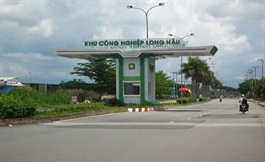Hanoi’s office market impacted by rising tide of companies leaving
Hanoi’s office market impacted by rising tide of companies leaving
The fact that companies are withdrawing from the market in droves or facing financial pressure took a toll on the office space market in Hanoi in the first half of this year, according to experts from real estate consultancy Savills Vietnam.

Given the economic downturn in the year to date, lots of tenants have been forced to revise their budget for renting office space or even return it before the lease expires.
Statistics from Savills Vietnam showed that the supply of office space in the Vietnamese capital city in the second quarter of this year was 2.14 million square meters, down two percent quarter on quarter and one percent year on year, after a grade-A and two grade-C projects closed for internal use.
The office market in the city also witnessed changes in terms of rent and occupancy.
The first seven months of the year saw a declining number of newly-established firms, in contrast to a surging number of businesses quitting the market.
Moreover, a host of companies experienced financial woes, significantly affecting office occupancy rates in the capital city.
Between January and June this year, newly-leased space fell 33,400 square meters compared to the year-ago figure, with the grade-B segment reporting the biggest decrease of minus 26,500 square meters.
Hoang Nguyet Minh, senior director for commercial leasing at Savills Hanoi, pointed out two reasons behind the falling occupancy in the office market.
First, the number of tenants paying office rent of over US$40 per square meter receded, with tenants preferring leases with more affordable prices.
Second, despite making robust performance during the COVID-19 pandemic and in 2022, ICT firms throughout Southeast Asia, particularly tech startups, are slowing after a hot period.
In Hanoi, a number of ICT companies terminated their contracts for renting office space early.
During the 2021-22 period, ICT enterprises took the lead in office space demand, but that demand began dipping in 2023 after funds cut their investment in startups due to an economic slowdown.
Consequently, ICT firms had to scale down their rented space or even return it to landlords prematurely.
Previously, the number of transactions by ICT firms accounted for 32 percent, which then halved this year.
Since the start of 2023, most office space transactions were linked to manufacturing businesses, which felt a lower impact from the economic downturn than those in other fields.
Education institutions such as language centers, computer training centers, or representative offices of foreign universities in Vietnam ranked second in demand for office space.
The office market is expected to see major transactions associated with consulting, finance, and law companies during the rest of the year. These tenants could need office space measuring some 200-500 square meters each.
To remain competitive and uphold occupancy, lots of landlords are lowering rent and intensifying promotions to support tenants.
Meanwhile, tenants are prioritizing costs when accessing their lease options and favor buildings within the same grade with more affordable prices.
Transactions in the office market range between $20 and $35 per square meter. Buildings offered for lease in this rent range had a higher occupancy rate than those offered at $40-50 square meters.
In Hanoi, office rent and occupancy are forecast to improve by the end of 2023. The new office stock could reach some 80,279 square meters, with the Lotte Mall project making up 38 percent.
Data from the General Statistics Office of Vietnam revealed that during the first seven months of this year, 66,800 firms nationwide temporarily ceased operations, rising 19.3 percent year on year; 36,000 businesses were in the process of dissolution, inching up nearly 28 percent; and 10,400 firms completed dissolution procedures, up a mere 0.6 percent.
In Hanoi, 16,900 enterprises halted operations or were dissolved, up 29 percent versus last year and setting a record high so far.
In addition, newly-founded firms and those resuming operations fell for the first time since the first half of 2020.






















